Farewell to Philae
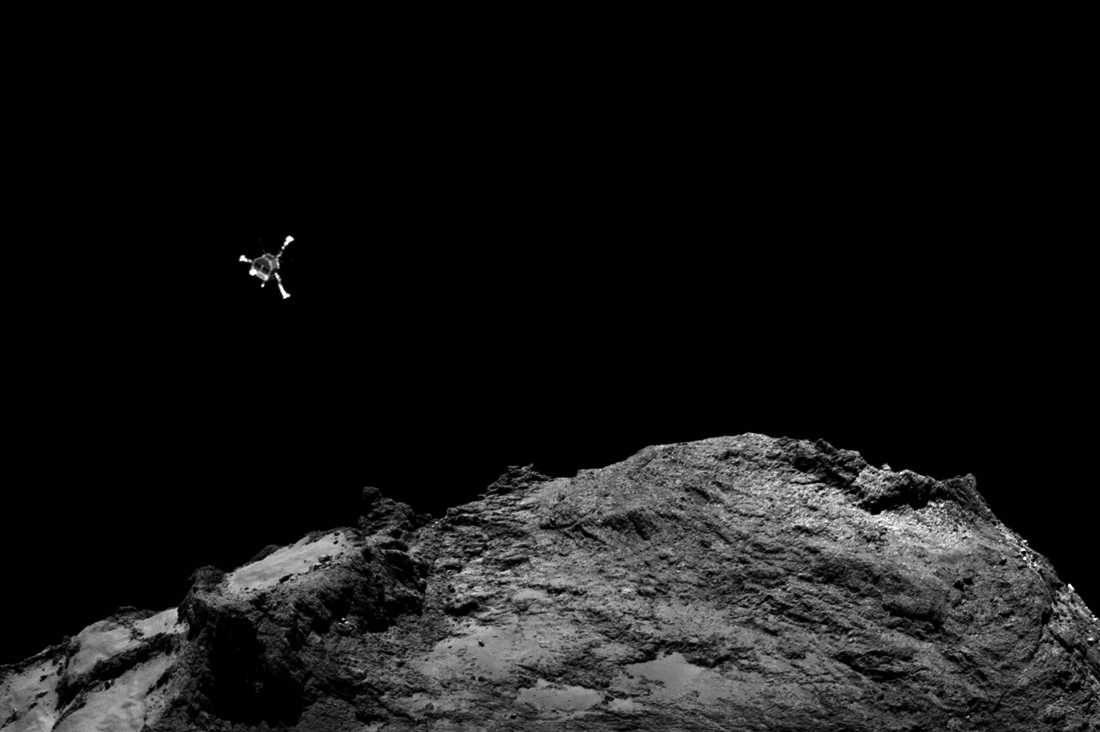
The spacecraft, which on November 12, 2014, gently touched the surface of comet 67P / Churyumov-Gerasimenko for more than six months does not show signs of life. Philae Lander can claim a state award for work despite all the circumstances. Having survived a decade-long flight and an emergency landing, he still managed to heroically accomplish his task, and conduct a study of the comet while he allowed the batteries to charge. In the summer of 2015, he surprised everyone by returning to life, but today there is almost no opportunity to repeat this feat.
The European Space Agency’s Rosetta automatic interplanetary station, with the Philae landing gear (read as “Philé”, but after getting acquainted with it, I don’t want to call anything other than “Phil”), set off in 2004 to study comet 67P / Churyumova-Gerasimenko. In the summer of 2014, Rosetta and the comet nucleus converged. Such a long journey the spacecraft had to go through because the task was not only to meet the comet, but also to stay close to it. That is, the counter trajectories from which comets studied earlier were not suitable for this expedition. It took the apparatus ten years and five gravitational maneuvers to get close to the comet and to equalize the speed with it.
In addition to exploring the comet from a distance, the mission assumed direct contact with the comet's core. Landing was to make a descent module Philae Lander. Having studied the comet from a distance, the scientists chose a suitable place for landing. It was a flat place called Hagilkiya at the comet's South Pole.
')

November 12, 2014 Philae successfully undocked from Rosetta and went to meet with the comet. The trajectory was chosen flawlessly and nothing foreshadowed problems, but the last meters of the flight were emergency.
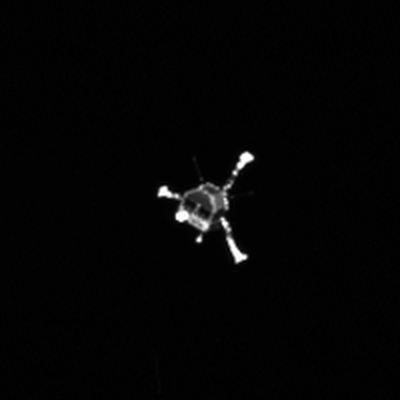
The force of attraction of a four-kilometer piece of ice and dust is not high, so Philae was equipped with several tools that were supposed to keep him on the surface. A few meters from the comet, the apparatus had to shoot special harpoons in order to gain a foothold in the regolith.
The shot did not happen.
Touching the surface, Philae had to turn on rocket engines, which were supposed to blow up and press the machine to the comet.
Engines did not work.
While the engines were running, the module had to screw the borax on its feet into the surface in order to firmly fix itself on the surface. But without harpoons and engines, a dramatic fate awaited him, in which the Boers were useless. Despite the hardware problems, Philae was lucky that the loose soil absorbed some of the kinetic energy, and the device did not reject into space. But the probe bounced, flew several hundred meters and stopped only after the fourth jump.
The final landing site was very different from what was previously prepared. In fact, Philae was stuck in a crack several meters deep. No one knew the place of its actual landing. The camera inspection results and the solar energy production data showed that this is a rather dark place. The scientists had about two or three days to realize the full scientific potential of Philae, to use all research instruments and tools, until the supply of batteries is exhausted.

According to scientists, for 64 hours of work Philae they managed to implement 80% of the scientific program of the probe. Philae was able to check the surface hardness and measure its temperature with a MUPUS penetrometer, inspect the surface with ROLIS cameras, and “enlighten” it with the CONSERT geo-radar. Ptolemy and COSAC chromatographs were able to “inhale” the comet gases and study the composition of its dust. Moreover, due to the rebound of the device, it was possible to conduct a study in two parts of the surface.
What could Phil know?
As in general, it was previously assumed that a comet is a mixture of ice and dust, and a rather loose consistency. According to radar scanning, the porosity is 75-85%. At the same time, the surface directly at the landing site turned out to be unexpectedly hard. Drummer could not move deeper than 3 cm of loose dust. Then he was blocked by hard ice.
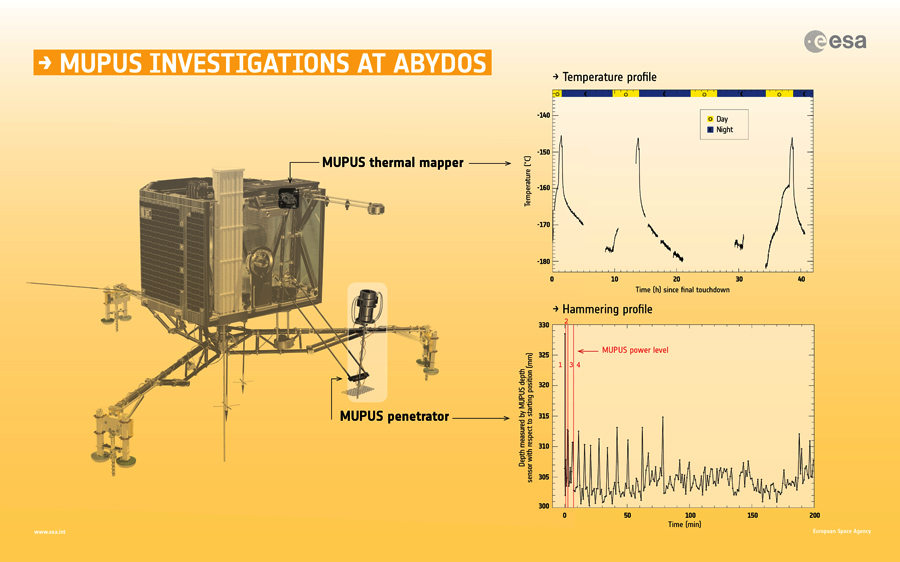
The detected gases at the cometary nucleus surface showed a rich set of organic compounds: formaldehyde, methyl isocyanate, acetone, propionaldehyde, acetamide, and 11 more organic compounds rich in carbon and nitrogen. The basis of the atmosphere was water vapor, carbon monoxide and carbon dioxide. The researchers note that the detected organic compounds are involved in the synthesis of amino acids, sugars, nucleotides and nitrogenous bases - i.e. are ready-made "bricks" of life. This does not prove that somewhere besides Earth there is life, rather confirms the hypothesis that comets played a significant role in shaping life on Earth and could bring organic "blanks" onto the planet, from which, ultimately, we . So, continuing the thought of Karl Sagan, we consist not only of stellar matter, but also of cometary. Maybe there is such a craving for space flight?
Unfortunately, the CONSERT radar did not have time to establish the origin of the comet's double structure. For a full-fledged study of the core of the nucleus, the signals were supposed to be sent to Rosetta, and she already had to ply the back of the comet and receive the CONSERT transmission. Due to limited working hours, we managed to walk “on tops” , without going further than 100 meters into the body of the comet.

After 64 hours, Philae fell asleep . Those. went into hibernation mode, in which he stayed during the flight. At first, scientists gave very optimistic forecasts for his awakening: first in a week, then in two, then in two months. But the device was silent. The comet was approaching the Sun, so it was expected that the Philae batteries would receive more energy and this would allow recharging the batteries and return to work. According to the preliminary program, if the landing was a success on the plain, then by March 2015 the scorching rays of the Sun would lead to overheating and failure of the device. But the shadow of the crack protected the apparatus, although it did not give him the opportunity to return to work.
In the summer of 2015, scientists decided to repeat attempts to get in touch. Direct contact of Philae with the Earth was impossible, so Rosetta acted as a repeater. And the near Sun made its own corrections - the surface of the comets heated up, the evaporation increased, the coma enveloped the core and did not allow to approach the surface.
At the same time, sunlight provided a chance for Philae to recover. In any case, it was impossible to simply turn on the transmitter and start broadcasting. The probe lay in a crack, and its antenna rested against the wall, instead of rising above the plain, as the original program suggested. Therefore, the first thing engineers needed was to find the optimal Rosetta trajectory that would allow it to effectively exchange signals with Philae.

In general, everyone who is interested in astronautics and is engaged in, or wants to ever be engaged in the development of space technology, I strongly recommend reading the blog entry of the Rosetta mission in the original . This is a real space detective!
I will try to give a brief retelling:
In June 2015, Rosetta began transmitting signals to the comet, expecting to receive a response from Philae. Previous attempts in March ended in failure, so on June 11-12, we had to assemble an engineering team and discuss the viability of new attempts to get in touch. And a day later Philae answered !
While we were enjoying the good news, the scientists and engineers of the mission tried to diagnose the device sitting and optimize the trajectory of the flying one. To return to scientific activity in the normal mode, it was necessary to accept the volume of telemetry data — the recording of information about the state of Philae from the moment it was re-enabled until the moment of establishing a connection. About 8 thousand telemetry packages stood in the queue, which would take 40 minutes of direct communication to transmit. The problem was that the first communication session lasted only 78 seconds; second session - 4 minutes; the third is 19 minutes. But the problems did not end and the sessions passed with frequent failures, as a result, it was possible to transmit a limited number of telemetry packets.

At the same time, the received data allowed to determine that the first Philae awakening took place on April 26, then on May 5 and 6, and then on June 13 by a signal from Rosetta. The account on board is maintained at “Comet day”, which lasts 12.5 hours.
The data from the solar panels made it possible to establish the intensity of illumination of each panel and helped to determine the exact location of the apparatus relative to the walls of the crack.
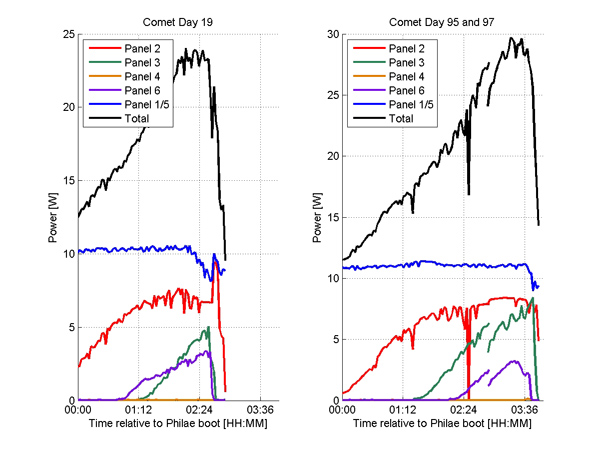
Telemetry for these days indicated a steady rise in the onboard temperature, which was an indicator of approaching the Sun. That was good news because deep frost prevented the operation of the apparatus.

On the other hand, the analysis of two airborne radios showed that one of them experienced a short circuit and failed.
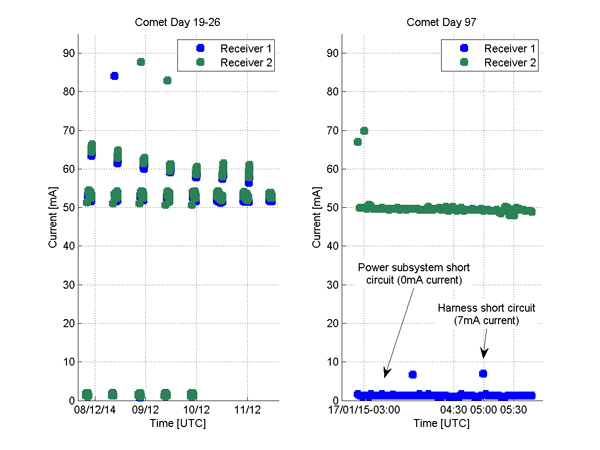
Hope remained for a second. In June, Rosetta conducted several communication sessions with Philae from a distance of 180-200 km, but she never managed to find the optimal mode and trajectory for stable contact. In July, the comet flew closer to the Sun, and Rosetta was forced to stay away from the nucleus so that dust did not block the optics of cameras and star sensors. And Philae did not answer.

The engineers decided that the second radio was also short-circuited. This would put an end to further work with the device. To check whether Philae hears Rosetta signals, they decided to use CONSERT radar. The idea was as follows: if the receivers are still working and the device as a whole is functioning, then a command is transmitted to it to use the georadar. Rosetta receives radar signals and confirms that Philae is still alive.
The team sent ... And did not receive a reply CONSERT. But immediately they were able to restore communication with the device at a distance of 155 km, i.e. one radio was still functioning. The devices managed to maintain a stable connection for 17 minutes. The engineers downloaded all the telemetry accumulated in the queue, and it seemed that nothing prevented the continuation of scientific work.
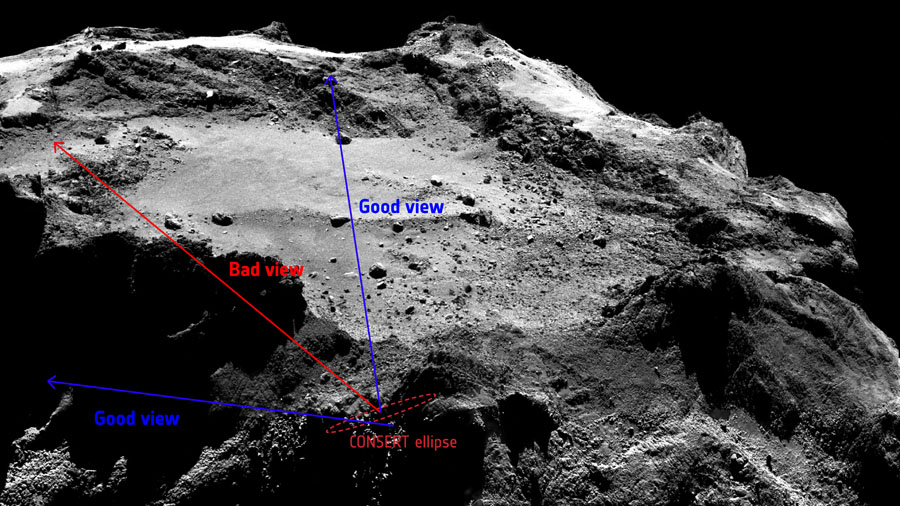
But Rosetta had its own scientific program. July 25, she had to move a different trajectory to study the opposite hemisphere of the comet, which excluded the possibility of establishing a connection. On August 13, the comet passed the nearest point with the Sun and began to gradually move away. A little later, Rosetta went 1.5 km away from the cometary nucleus — kept out of the dust and tried to study the shock wave of the coma.
Throughout the fall of 2015, there was hope to contact Philae again. At least the physical conditions on the comet should not have prevented this. However, it was not possible to contact so far. Now comet 67P / Churyumov-Gerasimenko has already retired beyond the orbit of Mars.
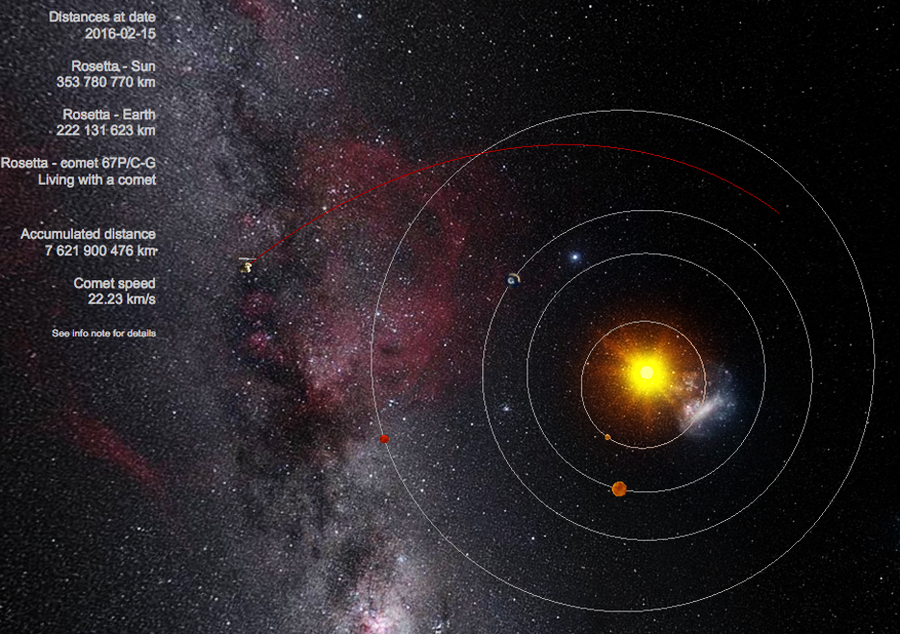
Rosetta whirls again at a close distance from the comet's nucleus, and continues to call Philae. The reasons for silence may be in the defective radio transmitters, or the solar panels are covered with dust and are no longer able to provide power to the device.

By the end of 2015, the temperature conditions in the crack, where the machine is stuck, are no longer compatible with its performance. Rosetta will still attempt to descend to 10 km and survey the proposed Philae landing site. However, there is practically no hope of a miraculous resurrection. So when we see Philae in the pictures, we can only say: Good-night, sweet prince.
Source: https://habr.com/ru/post/368129/
All Articles